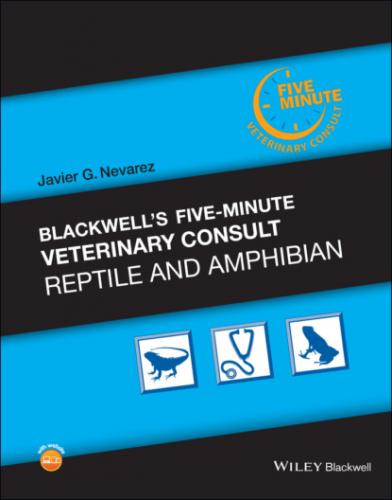Methylated xanthines (aminophylline and theophylline) have successfully induced diuresis.
Nothing is known about the potential use of spironolactone in reptiles.
PRECAUTIONS/INTERACTIONS
N/A
PATIENT MONITORING
Hemoculture, repeated echocardiographic examinations
EXPECTED COURSE AND PROGNOSIS
As no specific treatment is available, fast deterioration can be expected.
COMMENTS
N/A
ZOONOTIC POTENTIAL
Can be zoonotic in case of salmonellosis and other Gram‐negative bacteria.
SYNONYMS
Cardiovascular disease
Heart disease
ABBREVIATIONS
CK = creatine kinase
CT = computed tomography
ECG = electrocardiogram
LDH = lactate dehydrogenase
MRI = magnetic resonance imaging
Suggested Reading
1 Beaufrère H, Schilliger L, Pariaut R. Cardiovascular system. In: Mitchell MA, Tully TN, eds. Current Therapy of Exotic Animal Practice. St. Louis, MO: Elsevier; 2016:151–220.
2 Mitchell MA. Reptile cardiology. Vet Clin
3 North Am Exot Anim Pract 2009;12:65–79. Schilliger L, Girling S. Cardiology. In:
4 Divers S, Stahl S, eds. Mader’s Reptile and Amphibian Medicine and Surgery. St. Louis, MO: Elsevier; 2019:669–698.
Author Lionel Schilliger, DVM, DECZM (Herpetology), DABVP (Reptile & Amphibian Practice)
Cloacal Prolapse
DEFINITION/OVERVIEW
A prolapse is the moving or slipping of a body part from its usual position or anatomic relation. In the reptile, a prolapse from the vent may originate in the cloaca, rectum, phallus, oviduct, or bladder.
ETIOLOGY/PATHOPHYSIOLOGY
The underlying causes for prolapse is often unknown.
See Differential Diagnosis for a list of possible etiologies.
SIGNALMENT/HISTORY
There appear to be no specific signalments or predilections noted for the various reptilian prolapses.
Female reptilians may be overrepresented due to occurrences of dystocia.
CLINICAL PRESENTATION
A prolapse is easy to visualize as abnormal tissue protruding from the cloacal/vent region.
In reptiles housed outdoors and in case of small prolapses, the owners may not notice a problem until days after it has occurred.
A prolapse should be considered as an emergency and evaluated promptly.
The tissue should be kept moist by gently washing the area with water and loosely wrapping in a damp cloth or paper towel until the animal can be evaluated by a veterinarian.
The extruded tissue should be identified to the tissue(s) involved such as cloacal, with/ without bladder, oviduct, proctodeum, colon, phallus, etc.
Once the issues are identified, the clinician may be able to narrow the differential diagnoses (see below) to determine the course of diagnostics and therapeutics.
RISK FACTORS
In cases of nutritional secondary hyperparathyroidism, the muscle tone around the cloacal opening is decreased, leading to potential tissue exposure.
Any generalized physical straining of the patient can lead to tissue exposure through the cloaca, such as dyspnea, obstipation, parasites, infection, etc.
Space‐occupying lesions located in the coelomic cavity, such as uroliths, neoplasia, hepto/renomegaly, eggs, etc., may also cause increase straining and cloacal prolapse.
Husbandry
Several factors of husbandry may lead to one of the clinical conditions listed in the Differential Diagnosis section.
Corrections of the deficient aspects of the husbandry can lead to reversal of some of those listed conditions.
Others
Some cloacal tissue may prolapse during normal oviposition.
Iatrogenic prolapses may occur when owners attempt to manually manipulate ova in suspected cases of dystocia or feces in constipated animals.
DIFFERENTIAL DIAGNOSIS
Parasites
Hypocalcemia
Dehydration
Metabolic disease
Neoplasia
Impaction
Obstruction
Trauma
Coelomic space occupying lesion
Obesity
Bacterial Infection
Intoxication
DIAGNOSTICS
Radiography and ultrasound may be useful in determining internal abnormalities (e.g., impactions, masses, obstructions).
The small size of some reptiles may lead to reduced imaging detail, which makes interpretation challenging.
Dental radiographs may be a better alternative in smaller species (< 100 g).
A
